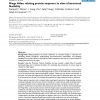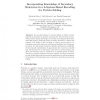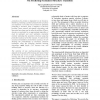315 search results - page 11 / 63 » Prediction of protein structural classes for low-homology se... |
BMCBI
2007
13 years 7 months ago
2007
Background: Relating features of protein sequences to structural hinges is important for identifying domain boundaries, understanding structure-function relationships, and designi...
BIBE
2003
IEEE
14 years 26 days ago
2003
IEEE
Contact map prediction is of great interest for its application in fold recognition and protein 3D structure determination. In this paper we present a contact-map prediction algor...
AE
2005
Springer
14 years 1 months ago
2005
Springer
An encoding scheme for protein folding on lattice models, inspired by parametric L-systems, was proposed. The encoding incorporates problem domain knowledge in the form of predesig...
CIKM
2009
Springer
14 years 2 months ago
2009
Springer
Background: Although both conservation and correlated mutation (CM) are important information reflecting the different sorts of context in multiple sequence alignment, most of ali...
IJBRA
2007
13 years 7 months ago
2007
A function of a protein is dependent on its structure; therefore, predicting a protein structure from an amino acid sequence is an active area of research. Optimally predicting a ...



